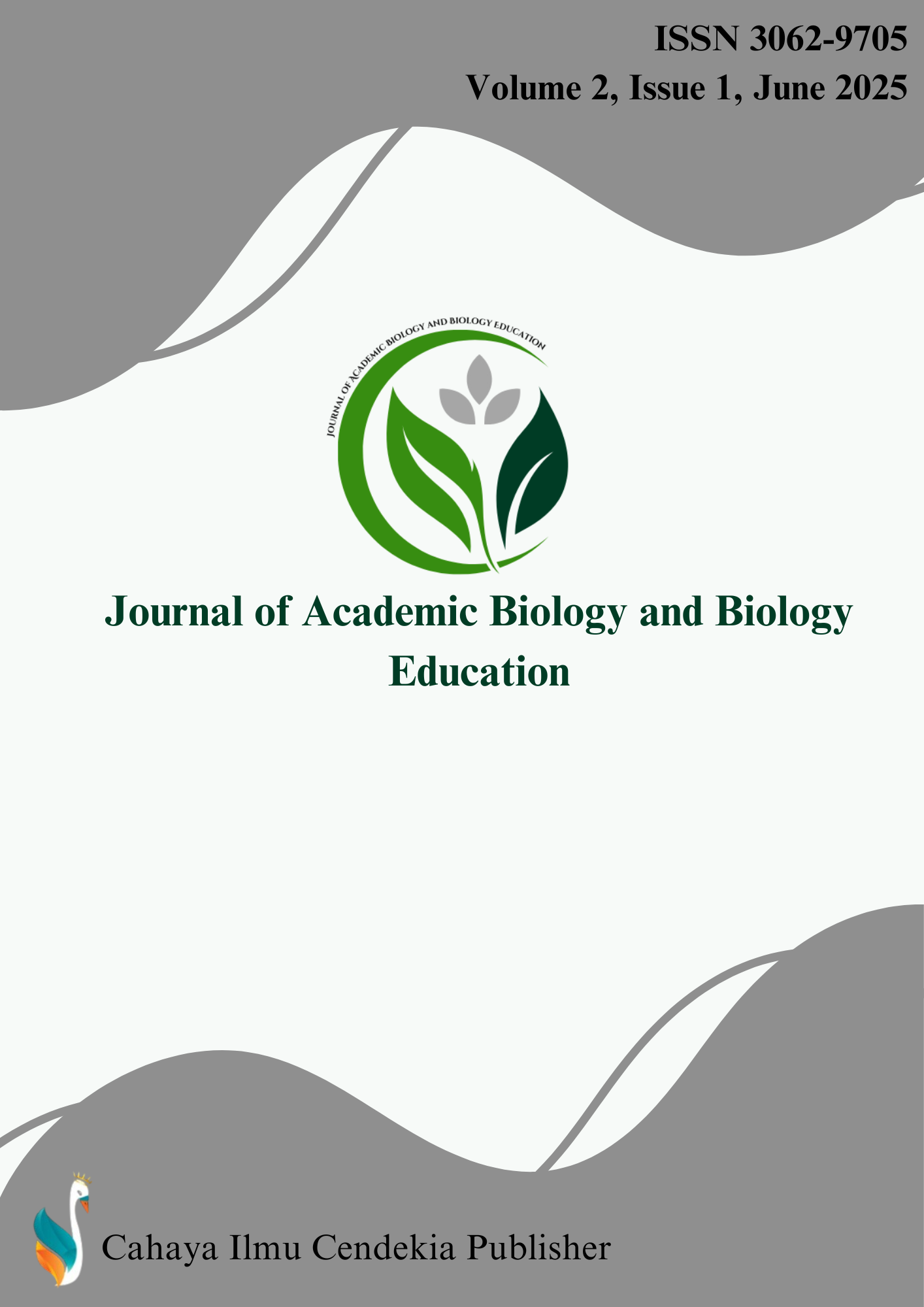Molecular Docking-Based in Silico Evaluation of Leaf Compounds from Coleus blumei Against MRSA
Abstract
Purpose of the study: This study aims to investigate the potential of compounds derived from medicinal plants as target protein inhibitors against methicillin-resistant Staphylococcus aureus (MRSA) using an in silico approach.
Methodology: This study employed an in silico molecular docking approach to evaluate active compounds from Coleus blumei leaves against MRSA. Target proteins included MecR1, PBP2a, and oxacilloyl-acylated MecR1. Docking was performed using PyRx, PyMOL, and Discovery Studio with molecular data sourced from GC-MS, PubChem, and PDB.
Main Findings: The compound Hexahydro-3H-cyclopenta[a]pentalen-3-one, 2,4a,5,6,7,8-hexahydro-4,4,7a-trimethyl-, (4aR,7R,7aS) demonstrated the highest binding affinity across all three MRSA resistance-associated target proteins (PBP2a, MecR1, and oxacillin-acylated MecR1), surpassing penicillin as the control. Molecular interaction visualizations revealed stable hydrogen bonding and hydrophobic interactions with key active site residues, particularly SER, LEU, and PHE in PBP2a. Pharmacokinetic evaluation based on Lipinski's Rule of Five indicated that top-performing compounds, including this compound and Aristolone, exhibit favorable oral drug-like properties. These findings highlight the strong potential of these natural compounds as lead candidates for the development of antibacterial agents targeting MRSA resistance mechanisms.
Novelty/Originality of this study: The novelty of this study lies in the utilization of specific natural compounds as potential antimicrobial agents against antibiotic resistance proteins, which have not been widely reported before. This study provides an initial basis for the development of herbal antimicrobial drug candidates for MRSA infections.
References
Y. Cao, “Exploring PBP2a resistance in MRSA by comparison between molecular covalent docking and non-covalent docking,” 2025.
N. Farid, K. Bux, K. Ali, A. Bashir, and R. Tahir, “Repurposing Amphotericin B: anti-microbial, molecular docking and molecular dynamics simulation studies suggest inhibition potential of Amphotericin B against MRSA,” BMC Chem., vol. 17, no. 1, pp. 1–16, 2023, doi: 10.1186/s13065-023-00980-9.
S. O. Oselusi, A. O. Fadaka, G. J. Wyckoff, and S. A. Egieyeh, “Computational Target-Based Screening of Anti-MRSA Natural Products Reveals Potential Multitarget Mechanisms of Action through Peptidoglycan Synthesis Proteins,” ACS Omega, vol. 7, no. 42, pp. 37896–37906, 2022, doi: 10.1021/acsomega.2c05061.
R. K. Alla, U. D. Medicharla, S. Mohammed, F. Abusua, A. B. P, and M. V. K, “rin t n ot ep Pr pe er re v iew rin t n ot Pr pe er re v ed,” vol. 5, no. 1, pp. 17–21, 2023.
A. Y. Al-Ghamdi, A. A. Fadlelmula, M. O. M. Abdalla, and S. A. Zabin, “Phytochemical Screening, Chemical Composition, Antimicrobial Activity and in Silico Investigation of the Essential Oil of Coleus forskohlii L. Collected from the Southwestern Region of Saudi Arabia,” J. Essent. Oil-Bearing Plants, vol. 24, no. 1, pp. 120–133, 2021, doi: 10.1080/0972060X.2021.1901613.
B. Negi et al., “Anti-methicillin resistant Staphylococcus aureus activity, synergism with oxacillin and molecular docking studies of metronidazole-triazole hybrids,” Eur. J. Med. Chem., vol. 115, no. March, pp. 426e – 437, 2016, doi: 10.1016/j.ejmech.2016.03.041.
M. Masumi, F. Noormohammadi, F. Kianisaba, F. Nouri, M. Taheri, and A. Taherkhani, “Methicillin-Resistant Staphylococcus aureus: Docking-Based Virtual Screening and Molecular Dynamics Simulations to Identify Potential Penicillin-Binding Protein 2a Inhibitors from Natural Flavonoids,” Int. J. Microbiol., vol. 2022, 2022, doi: 10.1155/2022/9130700.
M. A. Azam, S. Jupudi, N. Saha, and R. K. Paul, “Combining molecular docking and molecular dynamics studies for modelling Staphylococcus aureus MurD inhibitory activity,” SAR QSAR Environ. Res., vol. 30, no. 1, pp. 1–20, 2019, doi: 10.1080/1062936X.2018.1539034.
A. Szymkowiak, B. Melović, M. Dabić, K. Jeganathan, and G. S. Kundi, “Information technology and Gen Z: the role of teachers, the internet, and technology in the education of young people,” Technol. Soc., vol. 65, no. December 2020, 2021, doi: 10.1016/j.techsoc.2021.101565.
K. Altmeyer, S. Kapp, M. Thees, S. Malone, J. Kuhn, and R. Brünken, “The use of augmented reality to foster conceptual knowledge acquisition in STEM laboratory courses—Theoretical background and empirical results,” Br. J. Educ. Technol., vol. 51, no. 3, pp. 611–628, 2020, doi: 10.1111/bjet.12900.
H. M. Manukumar et al., “Novel T-C@AgNPs mediated biocidal mechanism against biofilm associated methicillin-resistant Staphylococcus aureus (Bap-MRSA) 090, cytotoxicity and its molecular docking studies,” Medchemcomm, vol. 8, no. 12, pp. 2181–2194, 2017, doi: 10.1039/c7md00486a.
Y. Karaca, “Computational complexity-based fractional-order neural network models for the diagnostic treatments and predictive transdifferentiability of heterogeneous cancer cell propensity,” Chaos Theory Appl., vol. 5, no. 1, pp. 34–51, 2023, doi: 10.51537/chaos.1249532.
J. B. Jarrett, K. L. Goliak, S. T. Haines, E. Trolli, and A. Schwartz, “Development of an entrustment-supervision assessment tool for pharmacy experiential education using stakeholder focus groups,” Am. J. Pharm. Educ., vol. 86, no. 1, pp. 15–20, 2022, doi: 10.5688/ajpe8523.
A. Syahid, “Indonesian journal of applied linguistics: a bibliometric portrait of ten publication years,” Libr. Philos. Pract., vol. 2021, pp. 1–24, 2021.
S. Guan et al., “Molecular docking and proteomics reveals the synergistic antibacterial mechanism of theaflavin with β-lactam antibiotics against MRSA,” Front. Microbiol., vol. 13, no. November, pp. 1–13, 2022, doi: 10.3389/fmicb.2022.993430.
S. Jurkaninová, R. Kubínová, M. Nejezchlebová, M. Gazdová, Z. Hanáková, and S. Dall’Acqua, “Anti-MRSA activity of abietane diterpenes from Coleus blumei Benth.,” Nat. Prod. Res., vol. 35, no. 18, pp. 3033–3039, 2021, doi: 10.1080/14786419.2019.1686371.
T. J. T. Medina and L. B. Cardenas, “Varieties As Basis for Explant Selection for Callus,” J. Nat. Stud., vol. 16, no. 1, pp. 1–10, 2017.
Sutomo et al., “Short communication: Plant diversity utilization and land cover composition in the Subak Jatiluwih, Bali, Indonesia,” Biodiversitas, 2021, doi: 10.13057/biodiv/d220345.
A. Astalini et al., “Identification of student character values in class X particle dynamics materials,” JIPF (Jurnal Ilmu Pendidik. Fis., vol. 8, no. 3, pp. 380–388, 2023, doi: 10.26737/jipf.v8i3.3776.
M. Taher, N. El-Daly, A. Y. El-Khateeb, S. Hassan, and E. A. Elsherbiny, “Chemical composition, antioxidant, antitumor and antifungal activities of methanolic extracts of Coleus blumei, plectranthus amboinicus and Salvia splendens (Lamiaceae),” J. Agric. Chem. Biotechnol., vol. 12, no. 11, pp. 177–187, 2021, doi: 10.21608/jacb.2021.209208.
C. Anatomy, O. F. Two, C. Species, and O. Value, “Comparative Anatomy of Two Cultivated Species of,” no. 1985, pp. 372–381, 2005.
M. Leaf and E. Against, “Biosaintifika,” vol. 11, no. 81, pp. 249–255, 2019.
N. A. Bismelah, R. Ahmad, Z. H. Mohamed Kassim, and N. H. Ismail, “Coleus blumei extract as a potential antibacterial oral rinse,” IOP Conf. Ser. Earth Environ. Sci., vol. 269, no. 1, 2019, doi: 10.1088/1755-1315/269/1/012015.
E. P. Motta et al., “The Anti-Virulence Effect of Vismia guianensis against Candida albicans and Candida glabrata,” Antibiotics, vol. 11, no. 12, pp. 1–24, 2022, doi: 10.3390/antibiotics11121834.
F. V. Delgado Rodríguez, N. T. Weng Huang, A. L. Gutierrez, D. Arias Nunez, and C. Rosales Leiva, “Ethnobotany, Pharmacology and Major Bioactive Metabolites from Impatiens Genus Plants and their Related Applications,” Pharmacogn. Rev., vol. 17, no. 34, pp. 338–381, 2023, doi: 10.5530/phrev.2023.17.13.
T. Gayatri et al., “Natural Products in Management of MDR BT - Natural Products for Antibacterial Drug Development: Recent Advancement of Computational Approach,” T. Sharma, C. R. Sahoo, D. Bhattacharya, and S. Pati, Eds., Singapore: Springer Nature Singapore, 2024, pp. 33–62. doi: 10.1007/978-981-97-9634-2_2.
Z. Zhang, Z. S. Zhang, X. Wang, G. L. Xi, Z. Jin, and Y. Z. Tang, “A click chemistry approach to pleuromutilin derivatives, evaluation of anti-MRSA activity and elucidation of binding mode by surface plasmon resonance and molecular docking,” J. Enzyme Inhib. Med. Chem., vol. 36, no. 1, pp. 2087–2103, 2021, doi: 10.1080/14756366.2021.1977931.
V. Schneider and A. Rohmann, “Arts in Education: A Systematic Review of Competency Outcomes in Quasi-Experimental and Experimental Studies,” Front. Psychol., vol. 12, no. April, pp. 1–13, 2021, doi: 10.3389/fpsyg.2021.623935.
P. Marvanová, T. Padrtová, R. Opatřilová, J. Pazourek, and P. Mikuš, “Abstracts of the 50th Conference Synthesis and Analysis of Drugs,” Separations, vol. 10, no. 1, p. 30, 2023, doi: 10.3390/separations10010030.
A. Musa et al., “Antimicrobial activities of the extracts and secondary metabolites from Clausena genus – A review,” Open Chem., vol. 20, no. 1, pp. 627–650, 2022, doi: 10.1515/chem-2022-0176.
M. M. Mohammed, M. A. Isa, M. B. Abubakar, A. S. B. Dikwa, and A. P. Kappo, “Molecular detection of mecA gene from methicillin-resistant Staphylococcus aureus isolated from clinical and environmental samples and its potential inhibition by phytochemicals using in vitro and in silico approach,” Silico Pharmacol., vol. 13, no. 1, p. 26, Feb. 2025, doi: 10.1007/s40203-024-00297-y.
A. Singh et al., “The development of thymol–isatin hybrids as broad-spectrum antibacterial agents with potent anti-MRSA activity,” RSC Med. Chem., vol. 15, no. 1, pp. 234–253, 2024, doi: 10.1039/D3MD00580A.
E. Cortes, J. Mora, and E. Márquez, “Modelling the anti-methicillin-resistant staphylococcus aureus (MRSA) activity of cannabinoids: A QSAR and docking study,” Crystals, vol. 10, no. 8, pp. 1–20, 2020, doi: 10.3390/cryst10080692.
L. Du et al., “Dockey: a modern integrated tool for large-scale molecular docking and virtual screening.,” Brief. Bioinform., vol. 24, no. 2, Mar. 2023, doi: 10.1093/bib/bbad047.
L. Ivanova and M. Karelson, “The impact of software used and the type of target protein on molecular docking accuracy,” Molecules, vol. 27, no. 24, p. 9041, Dec. 2022, doi: 10.3390/molecules27249041.
S. K. Kondapuram, S. Sarvagalla, and M. S. Coumar, “Chapter 22 - Docking-Based Virtual Screening Using PyRx Tool: Autophagy Target Vps34 as a Case Study,” M. S. B. T.-M. D. for C.-A. D. D. Coumar, Ed., Academic Press, 2021, pp. 463–477. doi: 10.1016/B978-0-12-822312-3.00019-9.
B. Larbaoui and R. Menad, “Single-click molecular docking via SwiftDock: A new virtual screening tool using AutoDock4,” Comput. Struct. Biotechnol. Reports, vol. 1, p. 100017, 2024, doi: 10.1016/j.csbr.2024.100017.
K. Hochberg, S. Becker, M. Louis, P. Klein, and J. Kuhn, “Using Smartphones as Experimental Tools—a Follow-up: Cognitive Effects by Video Analysis and Reduction of Cognitive Load by Multiple Representations,” J. Sci. Educ. Technol., vol. 29, no. 2, pp. 303–317, 2020, doi: 10.1007/s10956-020-09816-w.
G. Dishon, “The new natural? Authenticity and the naturalization of educational technologies,” Learn. Media Technol., vol. 46, no. 2, pp. 156–173, 2021, doi: 10.1080/17439884.2020.1845727.
N. M. D. Resiani and I. W. Sunanjaya, “The Efficiency of Water in Supporting Local Wisdom and Food Sustainability in Subak Sange, Bali Indonesia,” Agromet, 2020, doi: 10.29244/j.agromet.34.2.67-74.
A. H. Mohamed et al., “Novel quinoline/thiazinan-4-one hybrids; design, synthesis, and molecular docking studies as potential anti-bacterial candidates against MRSA,” RSC Adv., vol. 13, no. 21, pp. 14631–14640, 2023, doi: 10.1039/d3ra01721d.
Copyright (c) 2025 Pongpawan Sethanant, Junhong Kim, Maurizio Martin Cavani Brain

This work is licensed under a Creative Commons Attribution 4.0 International License.
Authors who publish with this journal agree to the following terms:
- Authors retain copyright and acknowledge that the Journal of Academic Biology and Biology Education is the first publisher licensed under a Creative Commons Attribution 4.0 International License.
- Authors are able to enter into separate, additional contractual arrangements for the non-exclusive distribution of the journal's published version of the work (e.g., post it to an institutional repository or publish it in a book), with an acknowledgment of its initial publication in this journal.
- Authors are permitted and encouraged to post their work online (e.g., in institutional repositories or on their website) prior to and during the submission process, as it can lead to productive exchanges and earlier and greater citation of published work.



.png)

.png)
.png)








